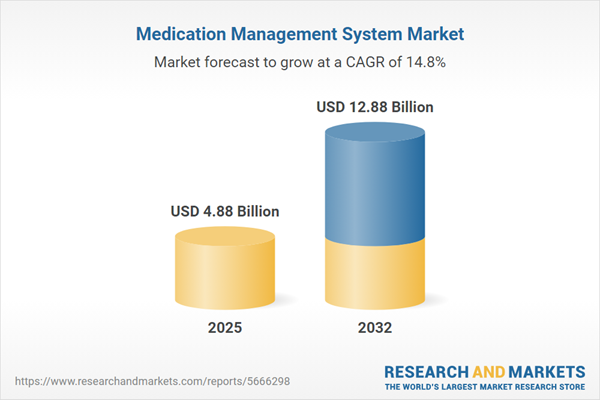Speak directly to the analyst to clarify any post sales queries you may have.
Medication management systems are transforming how healthcare organizations oversee medication workflows, support regulatory alignment, and drive operational reliability across multiple care settings. As these systems become core components of digital health initiatives, they enable leaders to embed sustainable best practices in medication safety and optimize process efficiency.
Market Snapshot: Medication Management System Market Growth
In 2024, the medication management system market reached a value of USD 4.25 billion and is projected to increase to USD 4.88 billion in 2025, arriving at USD 12.88 billion by 2032 and marking a compound annual growth rate (CAGR) of 14.83%. This growth is underpinned by accelerating adoption of integrated digital solutions that highlight automation, precision, and advanced analytics in medication processes. Healthcare providers are utilizing these platforms to streamline complex medication workflows, strengthen compliance, and reduce the risk of errors. The market benefits further from both public and private sector investments focused on resilience and flexible strategies for evolving healthcare needs.
Scope & Segmentation of the Medication Management System Market
This report delivers comprehensive analysis for senior executives aiming to align technical adoption with operational and clinical imperatives. The breadth of analysis spans multiple relevant segments, each vital to supporting effective decision making and tailored strategy deployment within the market:
- Deployment Mode: Examines cloud-based, on-premises, and hybrid solutions, with attention to interoperability, data privacy requirements, and suitability across diverse healthcare environments.
- Component: Focuses on automated dispensing units, barcode-scanning technologies, embedded software, and support services, all contributing to the integrity and traceability of medication flows.
- Application: Addresses use cases such as point-of-care automation, integrated pharmacy workflow optimization, and modules for ensuring care continuity and documentation accuracy.
- End User: Highlights adoption dynamics in hospitals, outpatient facilities, pharmacies, and specialty care centers, recognizing their unique operating needs and the demands of varying patient safety priorities.
- Geography: Analyzes regional trends in the Americas, Europe, Middle East & Africa, and Asia-Pacific, incorporating the impact of local regulatory frameworks, IT infrastructure maturity, and workforce readiness for digital transformation.
- Leading Companies: Details the competitive landscape by profiling key participants and strategic alliances, including Omnicell, McKesson, Becton, Dickinson and Company, Cerner, Cardinal Health, ScriptPro, Swisslog Healthcare, Talyst, ARxIUM, and Kit Check.
Key Takeaways for Senior Decision-Makers
- Implementing advanced medication management platforms supports durable compliance programs and enhances standardization, reducing process variability in medication practices.
- Integration of analytics, including AI capabilities, improves monitoring for medication discrepancies and drives proactive interventions, enhancing overall patient safety and operational oversight.
- Evolving compliance standards prompt organizations to select platforms with robust reporting and monitoring functionalities, ensuring readiness for regulatory changes and audits.
- Attention to technology compatibility and user skill level is necessary for successful system deployment and scaling, minimizing risk associated with infrastructure heterogeneity.
- Building strong relationships with technology providers strengthens adaptability, allowing organizations to efficiently navigate future market dynamics or shifting compliance requirements.
- Committing to structured training programs elevates workforce technical proficiency and maximizes returns on digital health investments over time.
Tariff Impact: Navigating 2025 U.S. Adjustments
Forthcoming U.S. tariff changes are influencing how healthcare entities assess supplier relationships and procurement strategies. Many organizations are expanding supplier networks, considering local sourcing, and diversifying vendor arrangements to improve supply chain stability. Technology providers are adapting contract terms while manufacturers increase domestic production, ensuring business continuity and maintaining accessible, compliant solutions.
Methodology & Data Sources
The insights within this analysis are underpinned by industry-leading datasets, current regulatory reference points, peer-reviewed findings, and direct consultations with clinical and pharmacy professionals. Rigorous adherence to evidence-based practices ensures accuracy in evaluating technology uptake and impact within the medication management system market.
Why This Report Matters
- Offers clear guidance for aligning technology selection with compliance needs and enterprise transformation objectives.
- Equips executives with actionable insights to refine vendor strategies, lower risks, and enhance allocation of operational and clinical resources.
- Supports informed procurement and workforce development for agile, effective technology deployment in diverse healthcare contexts.
Conclusion
Senior healthcare leaders using this analysis are positioned to guide the integration of advanced medication management solutions, reinforce regulatory alignment, and continually elevate standards in medication governance and patient care delivery.
Additional Product Information:
- Purchase of this report includes 1 year online access with quarterly updates.
- This report can be updated on request. Please contact our Customer Experience team using the Ask a Question widget on our website.
Table of Contents
3. Executive Summary
4. Market Overview
7. Cumulative Impact of Artificial Intelligence 2025
Companies Mentioned
The companies profiled in this Medication Management System market report include:- Omnicell, Inc.
- McKesson Corporation
- Becton, Dickinson and Company
- Cerner Corporation
- Cardinal Health, Inc.
- ScriptPro, LLC
- Swisslog Healthcare, Inc.
- Talyst, L.P.
- ARxIUM, Inc.
- Kit Check, Inc.
Table Information
| Report Attribute | Details |
|---|---|
| No. of Pages | 183 |
| Published | October 2025 |
| Forecast Period | 2025 - 2032 |
| Estimated Market Value ( USD | $ 4.88 Billion |
| Forecasted Market Value ( USD | $ 12.88 Billion |
| Compound Annual Growth Rate | 14.8% |
| Regions Covered | Global |
| No. of Companies Mentioned | 11 |









